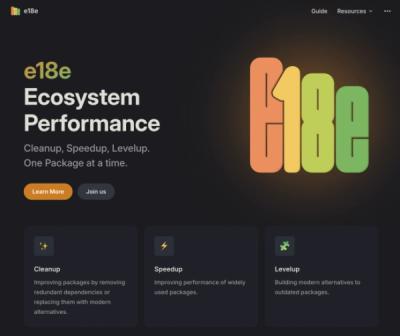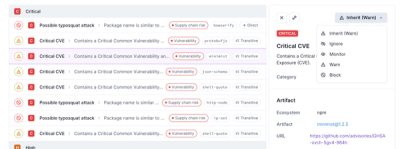
Research
Security News
Malicious npm Package Typosquats react-login-page to Deploy Keylogger
Socket researchers unpack a typosquatting package with malicious code that logs keystrokes and exfiltrates sensitive data to a remote server.
@aws-sdk/client-rbin
Advanced tools
Package description
@aws-sdk/client-rbin is an AWS SDK for JavaScript package that allows developers to interact with the Amazon Recycle Bin service. This service helps manage retention rules for resources, enabling users to recover resources that were accidentally deleted.
Create a Retention Rule
This feature allows you to create a retention rule for a specific resource type, such as EBS snapshots. The code sample demonstrates how to create a rule that retains EBS snapshots for 7 days.
const { RbinClient, CreateRuleCommand } = require('@aws-sdk/client-rbin');
const client = new RbinClient({ region: 'us-west-2' });
const createRule = async () => {
const params = {
RetentionPeriod: { RetentionPeriodValue: 7, RetentionPeriodUnit: 'DAYS' },
ResourceType: 'EBS_SNAPSHOT',
Description: 'Retention rule for EBS snapshots'
};
const command = new CreateRuleCommand(params);
const response = await client.send(command);
console.log(response);
};
createRule();List Retention Rules
This feature allows you to list all the retention rules that have been created. The code sample demonstrates how to retrieve and display the list of retention rules.
const { RbinClient, ListRulesCommand } = require('@aws-sdk/client-rbin');
const client = new RbinClient({ region: 'us-west-2' });
const listRules = async () => {
const command = new ListRulesCommand({});
const response = await client.send(command);
console.log(response);
};
listRules();Delete a Retention Rule
This feature allows you to delete a specific retention rule by its identifier. The code sample demonstrates how to delete a rule using its unique ID.
const { RbinClient, DeleteRuleCommand } = require('@aws-sdk/client-rbin');
const client = new RbinClient({ region: 'us-west-2' });
const deleteRule = async (ruleId) => {
const command = new DeleteRuleCommand({ Identifier: ruleId });
const response = await client.send(command);
console.log(response);
};
deleteRule('your-rule-id');The @aws-sdk/client-ec2 package allows developers to interact with Amazon EC2 services, including managing instances, volumes, and snapshots. While it does not specifically handle retention rules, it provides broader functionality for managing EC2 resources.
The @aws-sdk/client-s3 package is used to interact with Amazon S3 services, including managing buckets and objects. It offers lifecycle policies for managing object retention and deletion, which is somewhat similar to the retention rules in the Recycle Bin service.
The @aws-sdk/client-backup package allows developers to manage AWS Backup services, including creating backup plans and managing backup vaults. It provides functionalities for data protection and recovery, which are related to the retention and recovery features of the Recycle Bin service.
Changelog
3.600.0 (2024-06-18)
Readme
AWS SDK for JavaScript Rbin Client for Node.js, Browser and React Native.
This is the Recycle Bin API Reference. This documentation provides descriptions and syntax for each of the actions and data types in Recycle Bin.
Recycle Bin is a resource recovery feature that enables you to restore accidentally deleted snapshots and EBS-backed AMIs. When using Recycle Bin, if your resources are deleted, they are retained in the Recycle Bin for a time period that you specify.
You can restore a resource from the Recycle Bin at any time before its retention period expires. After you restore a resource from the Recycle Bin, the resource is removed from the Recycle Bin, and you can then use it in the same way you use any other resource of that type in your account. If the retention period expires and the resource is not restored, the resource is permanently deleted from the Recycle Bin and is no longer available for recovery. For more information about Recycle Bin, see Recycle Bin in the Amazon Elastic Compute Cloud User Guide.
To install the this package, simply type add or install @aws-sdk/client-rbin using your favorite package manager:
npm install @aws-sdk/client-rbinyarn add @aws-sdk/client-rbinpnpm add @aws-sdk/client-rbinThe AWS SDK is modulized by clients and commands.
To send a request, you only need to import the RbinClient and
the commands you need, for example ListRulesCommand:
// ES5 example
const { RbinClient, ListRulesCommand } = require("@aws-sdk/client-rbin");
// ES6+ example
import { RbinClient, ListRulesCommand } from "@aws-sdk/client-rbin";
To send a request, you:
send operation on client with command object as input.destroy() to close open connections.// a client can be shared by different commands.
const client = new RbinClient({ region: "REGION" });
const params = {
/** input parameters */
};
const command = new ListRulesCommand(params);
We recommend using await operator to wait for the promise returned by send operation as follows:
// async/await.
try {
const data = await client.send(command);
// process data.
} catch (error) {
// error handling.
} finally {
// finally.
}
Async-await is clean, concise, intuitive, easy to debug and has better error handling as compared to using Promise chains or callbacks.
You can also use Promise chaining to execute send operation.
client.send(command).then(
(data) => {
// process data.
},
(error) => {
// error handling.
}
);
Promises can also be called using .catch() and .finally() as follows:
client
.send(command)
.then((data) => {
// process data.
})
.catch((error) => {
// error handling.
})
.finally(() => {
// finally.
});
We do not recommend using callbacks because of callback hell, but they are supported by the send operation.
// callbacks.
client.send(command, (err, data) => {
// process err and data.
});
The client can also send requests using v2 compatible style. However, it results in a bigger bundle size and may be dropped in next major version. More details in the blog post on modular packages in AWS SDK for JavaScript
import * as AWS from "@aws-sdk/client-rbin";
const client = new AWS.Rbin({ region: "REGION" });
// async/await.
try {
const data = await client.listRules(params);
// process data.
} catch (error) {
// error handling.
}
// Promises.
client
.listRules(params)
.then((data) => {
// process data.
})
.catch((error) => {
// error handling.
});
// callbacks.
client.listRules(params, (err, data) => {
// process err and data.
});
When the service returns an exception, the error will include the exception information, as well as response metadata (e.g. request id).
try {
const data = await client.send(command);
// process data.
} catch (error) {
const { requestId, cfId, extendedRequestId } = error.$metadata;
console.log({ requestId, cfId, extendedRequestId });
/**
* The keys within exceptions are also parsed.
* You can access them by specifying exception names:
* if (error.name === 'SomeServiceException') {
* const value = error.specialKeyInException;
* }
*/
}
Please use these community resources for getting help. We use the GitHub issues for tracking bugs and feature requests, but have limited bandwidth to address them.
aws-sdk-js
on AWS Developer Blog.aws-sdk-js.To test your universal JavaScript code in Node.js, browser and react-native environments, visit our code samples repo.
This client code is generated automatically. Any modifications will be overwritten the next time the @aws-sdk/client-rbin package is updated.
To contribute to client you can check our generate clients scripts.
This SDK is distributed under the Apache License, Version 2.0, see LICENSE for more information.
FAQs
Unknown package
The npm package @aws-sdk/client-rbin receives a total of 171,575 weekly downloads. As such, @aws-sdk/client-rbin popularity was classified as popular.
We found that @aws-sdk/client-rbin demonstrated a healthy version release cadence and project activity because the last version was released less than a year ago. It has 5 open source maintainers collaborating on the project.
Did you know?

Socket for GitHub automatically highlights issues in each pull request and monitors the health of all your open source dependencies. Discover the contents of your packages and block harmful activity before you install or update your dependencies.

Research
Security News
Socket researchers unpack a typosquatting package with malicious code that logs keystrokes and exfiltrates sensitive data to a remote server.

Security News
The JavaScript community has launched the e18e initiative to improve ecosystem performance by cleaning up dependency trees, speeding up critical parts of the ecosystem, and documenting lighter alternatives to established tools.

Product
Socket now supports four distinct alert actions instead of the previous two, and alert triaging allows users to override the actions taken for all individual alerts.